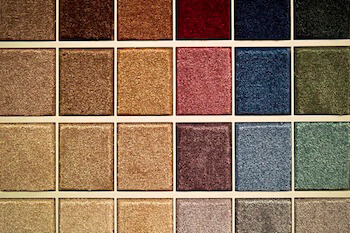How Well Is Your Carpet Made?
What gives carpeting its durability, its longevity, and ensures that it will look good and wear well in the years to come? There are many factors that go into carpet construction, each playing a role in the process: Carpets consist of:
- Fiber

- Backing
- The latex used to hold the backing together
- Density of pile
- Pile weight
- Twist of the fiber
- Finishing
- Stain resistance
- Dye method
Each part of the process plays a role in the durability. For instance, the best backing material wouldn’t give carpet strength if weak fibers were used in the process. While each plays a role, there are a few things you can look for when shopping for new carpets for your home.
Most carpeting is tufted or punched through the backing with a series of needles. Backing is a layer of material sandwiched together using latex glue. Fiber is pushed through the secondary backing, held in place with latex glue, and finished by the primary backing which holds the carpeting together. While the backing plays an important role, the glue will also determine the longevity. If the latex fails, the two backings will delaminate over time, causing the fibers to release and begin to fall out.
Most backing materials are a weave of plastic materials, but foam rubber, urethane and jute are also involved in the carpet making process. Foam rubber is often used in kitchen or indoor/outdoor carpeting and provides the cushion-like feel. Urethane holds fibers tighter and bonds the fibers to the backing, decreasing the risk for delamination. Jute is a superior backing, and was often used in decades past. However, the US is not able to import jute on a regular basis, and therefore you’ll usually only find jute in carpeting such as heavy berber or some wool carpets.
When shopping for carpet, you will find terms like “weight, density and twist”. These refer to the construction of the carpet’s surface.
Weight is the amount of fiber on the surface of the carpet expressed in ounces per square yard. Never buy carpet based on weight alone.
Density refers to how close together the strands of fiber are together at the base of the carpet. Density effects how the carpet is going to look and perform.
Twist level is the amount of twist the fibers are given during the time of construction. The more twist a carpet has, the less dense the carpet has to be, and can even impact the amount of fiber necessary during production.
A short, tight twist carpet is called a frieze, and is known to be the best wearing style of carpet outside of a loop pile, which you’ll often find in commercial carpets.
After production, finishing work is completed to give your carpets the final look and its durability factor. If the fibers are not crimped, the are sheared several times, and will eventually take on a velvet appearance (a super dense construction), a plush (less dense), or a saxony (even less dense construction). Velvets are formal and tend to show the most footprints and marks as you move across the floor. Plush are not as tight as the velvet construction, will still feel thick to the touch, and typically come in solid colors.
Some sort of stain treatment is added to virtually all types of carpeting today. However, there are no miracle stain treatments. Most treatments will wear off in five to seven years, leaving your carpeting more at risk as time goes by.
There are no right or wrong choices when it comes to choosing carpeting for your home. With many styles, options and durability factors, it depends on your tastes and how much traffic your room will ultimately receive. If you have any questions, we’d be happy to help you see the differences in the many samples we have on display.
